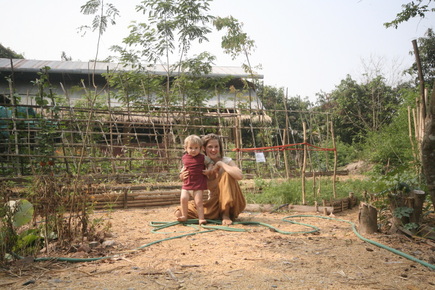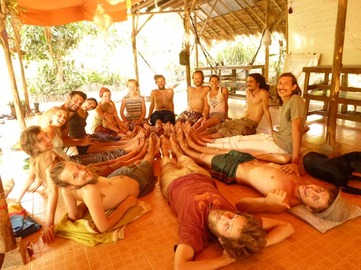The Panya project
The Panya project is an intentional community in Northern Thailand which focuses on sharing and teaching permaculture. The community was originally started by an American, Christian Shearer, after he became inspired by Panya's neighbour, Punpun. The community is now run by a group of long term volunteers (who change reguarly) with most decisions for the project being made by the group living there at the time.
The project is quite large, and was started on land previously used as a commercial mango orchard. This means that the majority of large trees are mango trees, so during mango season there are more mango's than you can shake a stick at. The ground is literally covered in the squishy sweet fruit, and you often hear the thud-squish of a large ripe one falling on your rooftop whilst you are sleeping. Sounds like paradise for fruit lovers, and it is. Mango's are not the only fruit in Panya. Pineapples grow around every corner, mulberries, figs, avocado's, papaya, the list goes on and on.. Over the past 8 years there has been a lot of planting, replacing the mango's with a wider variety of food trees. And with a large area devoted to a young food forest, in a few years time the place will be bursting with even more tropical fruit and nuts.
The project is quite large, and was started on land previously used as a commercial mango orchard. This means that the majority of large trees are mango trees, so during mango season there are more mango's than you can shake a stick at. The ground is literally covered in the squishy sweet fruit, and you often hear the thud-squish of a large ripe one falling on your rooftop whilst you are sleeping. Sounds like paradise for fruit lovers, and it is. Mango's are not the only fruit in Panya. Pineapples grow around every corner, mulberries, figs, avocado's, papaya, the list goes on and on.. Over the past 8 years there has been a lot of planting, replacing the mango's with a wider variety of food trees. And with a large area devoted to a young food forest, in a few years time the place will be bursting with even more tropical fruit and nuts.

The gardens are well established, and there are two main areas, a companion planting area and a series of beds that are planted and maintained to biodynamic methods. Quite a lot of food is grown here, but not enough to always cover the needs of the many visitors and volunteers so veg is supplemented from the local markets.
Food is cooked on a rotational basis, with all volunteers having a chance to make food for everybody else. All food is vegetarian, though eggs are included. There is never a shortage of big dinners, and evenings are often spent with a big belly.
Water is provided for the site through a gravity-fed system of rainwater running from large tanks at the top of the property. Drinking water is pure rain water, collected in tanks by the main living area.
There is one solar panel which provides electricity for lighting and charging laptops etc, whilst mains electric provides power for everything else.
Working at Panya
Mornings are spent working together as a community. The working day starts at 9am, after a communal breakfast, and ends at 12pm when lunch is cooked. The rest of the day is free time, well, unless you are involved in any of the other thousand tasks involved in the upkeep of the place. Personal projects, meetings, cooking rotations, it all takes place after the morning session.

People at Panya
Decisions for the project are made by a process of consensus, in regular group meetings which all long-termers attend. A long term volunteer is somebody who has committed to staying at least 6 months and has a passion for and experience in permaculture. These volunteers are responsible for all areas of the farm on a management rotation basis, so everybody gets a chance to experience all workings of the project. They also have main management areas which they are responsible for overseeing on a longer term basis, so people with more experience or passion in certain areas can be responsible to see that area develop in the best way.
Less responsibility is given over to mid term volunteers, who commit for a minimum of three months, and take on more individual responsibility for the upkeep and development of the site but who don't make any major decisions. And then there are the short term volunteers, those who come to stay for as long as they like, to learn, help out with whatever jobs need doing, and generally have a chilled out and lovely time.
Decisions for the project are made by a process of consensus, in regular group meetings which all long-termers attend. A long term volunteer is somebody who has committed to staying at least 6 months and has a passion for and experience in permaculture. These volunteers are responsible for all areas of the farm on a management rotation basis, so everybody gets a chance to experience all workings of the project. They also have main management areas which they are responsible for overseeing on a longer term basis, so people with more experience or passion in certain areas can be responsible to see that area develop in the best way.
Less responsibility is given over to mid term volunteers, who commit for a minimum of three months, and take on more individual responsibility for the upkeep and development of the site but who don't make any major decisions. And then there are the short term volunteers, those who come to stay for as long as they like, to learn, help out with whatever jobs need doing, and generally have a chilled out and lovely time.
Panya is a magical place. There is so much that can be learned from staying here. Come in the rainy season and you will be deafened and amazed by the chorus of thousands of frogs that emerge to sing in the soggy ponds. And if you like bugs you will love it here, the beetles, moths, spiders, butterflies, centipedes, scorpions, snakes (and of course, the mosquitoes...) totally amazing, if only a wee bit scary.. And if bugs aren't your thing, then the ducklings, geese and the army of cats are a good enough reason for visiting.
My personal thoughts
Ohli and I mostly loved our time at the Panya project. We felt welcomed and like a part of a family right from the beginning. We ended up staying with them for about 5 months in total, much longer than we had planned. For a child the location is magical, a big fruit filled jungle to explore, and and ever-changing circle of friendly people to hang out with and play in the gardens. As a parent I did find it a challenge in the end to balance all the work in the community with being there with a young child, (and whilst studying online needing internet access, which is pretty non-existent in Panya) but these challenges were entirely personal and I think it was just due to the great energy and learning environment of Panya that we managed to stay so long.
Here are just a few pictures from our stay at Panya.
My personal thoughts
Ohli and I mostly loved our time at the Panya project. We felt welcomed and like a part of a family right from the beginning. We ended up staying with them for about 5 months in total, much longer than we had planned. For a child the location is magical, a big fruit filled jungle to explore, and and ever-changing circle of friendly people to hang out with and play in the gardens. As a parent I did find it a challenge in the end to balance all the work in the community with being there with a young child, (and whilst studying online needing internet access, which is pretty non-existent in Panya) but these challenges were entirely personal and I think it was just due to the great energy and learning environment of Panya that we managed to stay so long.
Here are just a few pictures from our stay at Panya.
